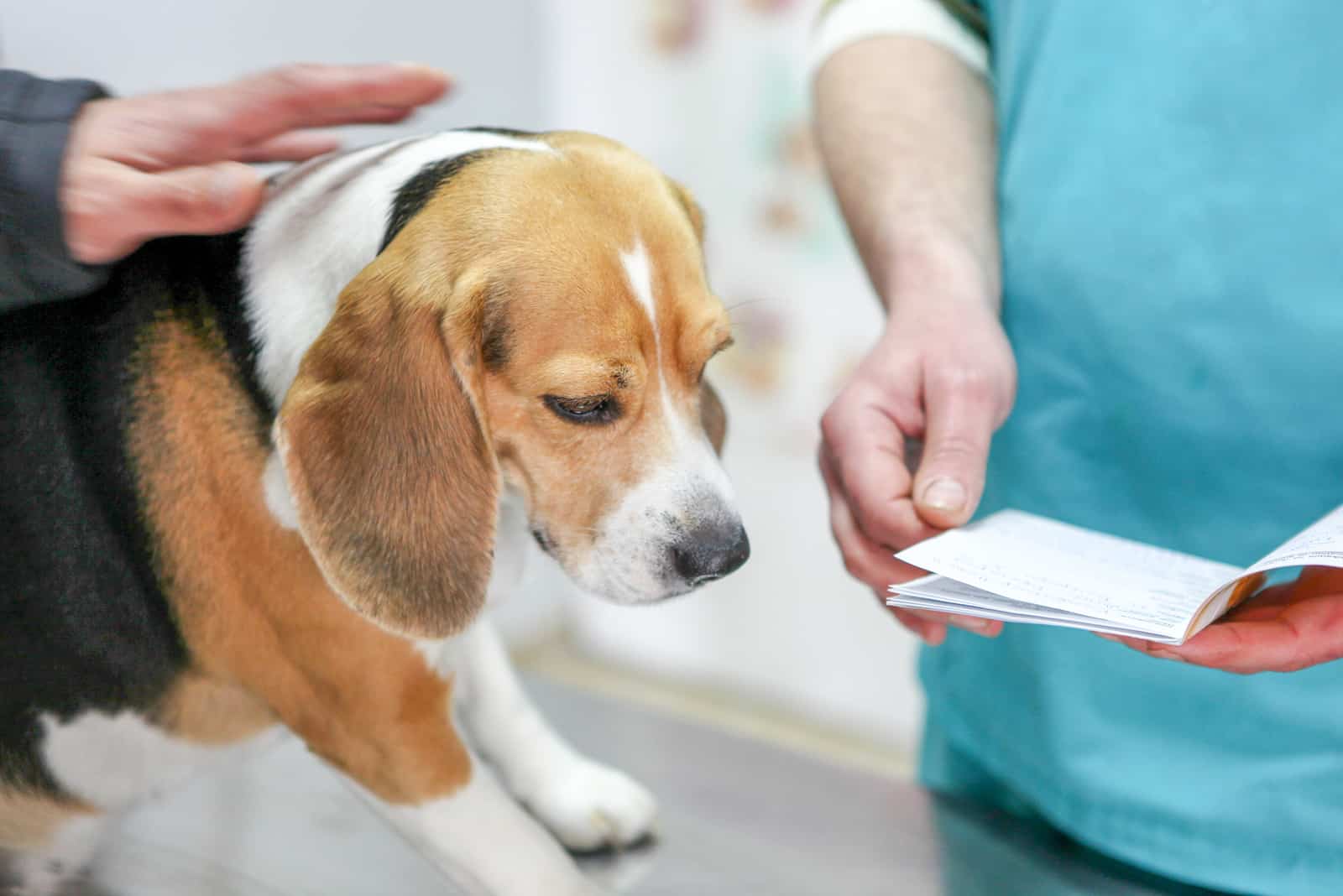While this might be a hard thing to cope with, our dogs grow old at a much faster rate than we do.
In fact, when considering a new family pet, many people look at the average lifespan of the breed before making their final choice.
So, what about Beagles? What is the Beagle lifespan, and what can you expect?
When it comes to determining how long our pets live, many things need to be considered. However, every dog breed has a specific life expectancy that you can use as a general overview.
Fortunately, our Beagle dogs will most likely stay by our side for quite some time, as the average Beagle lifespan is between 12 and 15 years. Many Beagles will exceed that range, so this is something to be happy about.
If you want to know what impacts the Beagle lifespan, you’re in the right spot. We’ll explain all the factors that affect this, as well as some diseases and issues you need to be aware of.
How Long Do Beagles Live?

Beagles are scent hounds, bred primarily for hunting hares, but in recent years, they’ve become great companions first and hunters second.
They are famous for their excellent sense of smell that aids them in the hunting season.
Because of this amazing sense, they are also used as detection dogs for imports in quarantine all over the world.
Considering all of this, it’s no wonder that Beagles are among the most popular dog breed worldwide. In fact, the American Kennel Club (AKC) ranks them anywhere between 4th and 6th place on its Most Popular Breed List.
Beagles can be seen in many movies and TV shows. Even one of the most famous dogs worldwide, Snoopy, is a Beagle!
The long Beagle lifespan has additionally helped solidify their reputation as good family pets. On average, these dogs live around 13 years, but they will often live longer than 15.
In fact, in recent years, there seems to be a slow increase in the Beagle lifespan. If we look at the records, we can see that in 1994, the average lifespan of the Beagle breed was 11 to 12 years.
Does Size Matter?

Beagles are a small dog breed, and this gives them a high likelihood of living longer than most larger breeds.
Most larger mammals tend to live longer than smaller ones. For example, elephants and whales will live longer than rodents or cats.
However, this is contradictory in dogs, in which smaller breeds, such as Chihuahuas, tend to outlive larger ones, such as Great Danes.
Is there a reason behind this?
A few evolutionary biologists noticed that most dog breeds tend to take the same time to grow from puppyhood to adulthood, no matter their size.
This means that larger dogs grow in an accelerated fashion compared to smaller ones.
When you have animals growing at such a rapid pace, this can increase the likelihood of abnormal cell growth, which can later lead to cancer.
For example, the Cane Corso lifespan is much shorter, and most of these dogs live between 10 and 11 years.
This is quite a lot shorter than the Beagle lifespan, despite the Cane Corso being a significantly larger dog breed.
Read More: Beagle Growth Chart
Leading Causes Of Death In Beagles

According to The Veterinary Medical Databases (VMDB), most Beagle puppies die from trauma, congenital diseases, and secondary infections.
These three are the leading cause of death in Beagles younger than two years old.
However, the most frequent cause of death in Beagles is cancer. It is responsible for 23.1% of deaths – and, unfortunately, this is much more frequent than most would hope.
The second most frequent cause of death is trauma, and approximately 16% of Beagles die from it. There isn’t much more to say about this.
It isn’t rare for dogs who escape to end up being struck by a car. These accidental deaths are sometimes even more tragic than most natural deaths.
Around 13% of Beagles die from neurological causes. This dog breed is prone to developing diseases of the neurological system – the most common being intervertebral disc disease (IVDD).
Factors Affecting The Beagle Lifespan

There are many things you should consider when wondering how long your dog will live. Of course, the biggest concern is health. Health problems can be:
• Acute
• Genetic
• Chronic
Acute problems happen just once. This might be an infection or some kind of an accident.
Genetic issues are inherited from one or both parents. You can avoid this by purchasing from a reputable breeder who will test their dogs for most genetic problems. Sure, this might increase the Beagle price, but it will be worth it.
Chronic problems are health issues that don’t have to be genetic but will last for a long time. Diabetes is a good example of this.
Conditions that fall in any of these categories can influence the Beagle lifespan negatively and cause your pup to live a shorter life. The Beagle type or bloodline doesn’t affect its health that much. So far, there are no indications that a Blue Tick Beagle lives longer than a standard Beagle. The same goes for gender.
Beagle Health Problems

Beagles are mostly healthy dogs. However, just like any other dog breed, they are prone to several health conditions. These include:
• Canine epilepsy
• Intervertebral disc disease (IVDD)
• Factor deficiency (FVII)
• Neonatal cerebellar cortical degeneration (NCCD)
• Steroid responsive meningitis (SRM)
• Canine distemper
• Obesity
We’ll explain how these influence the Beagle lifespan further on.
Beagles are also prone to some other health conditions that will rarely influence their life expectancy, such as:
• Ear infections, which are common in breeds with floppy ears
• Eye infections, such as glaucoma and cherry eye
• Joint problems, such as arthritis and hip dysplasia

Photo from: @davethebeagle
Canine Epilepsy And The Beagle Lifespan
Most dogs with canine epilepsy will live a normal life. However, if left untreated, this condition can be life-threatening.
No seizures are good for a dog’s health. Repetitive or severe seizures can cause brain damage that could lead to death.
There are three types of epilepsy in Beagles (primary, secondary, and reactive), and all three require medical treatment. Otherwise, things could go awry.
The cause of primary canine epilepsy isn’t known. This means the vet is only doing what they can to control the seizures.
In secondary epilepsy, the cause of seizures is usually a health condition such as a stroke or tumor.
The same goes for reactive epilepsy, which is attributed to diseases such as liver disease and kidney failure. All can be fatal.
Intervertebral Disc Disease And Beagle Lifespan

This neurological condition attacks the dog’s spinal cord. This is a degenerative condition that is usually age-related, so older dogs will be more likely to develop it.
However, some adult Beagles can develop issues with the intervertebral disc much earlier, causing degeneration. This can sometimes lead to paralysis of the back legs.
Sometimes, conservative management that includes only pain medication can be enough.
This is an adequate treatment for dogs with a milder case of this condition – however, be aware that it can also lead to further deterioration.
Some more severe cases may require surgery. Some dogs can recover almost entirely if surgery is successful.
IVDD won’t directly impact your dog, but it can become quite painful. If surgery doesn’t help, you might be faced with the decision of whether or not your dog should be euthanized.
Factor VII Deficiency And The Beagle Lifespan
Factor VII deficiency is a fairly rare disorder that can still affect many Beagles. It involves FVII, one of the main proteins involved in blood clotting. This can cause unusual or internal bleeding in dogs.
Fortunately, this condition is easy to manage, and routine surgery can fix most issues. After a successful surgery, the dog can have a normal lifespan.
However, it’s important to detect and diagnose this disease early before it’s too late for your pooch.
Neonatal Cerebellar Cortical Degeneration And The Beagle Lifespan

NCCD is a disorder that usually affects Beagle puppies. It remained a mystery until 2012 when a group of scientists finally identified the gene mutation causing it.
This mutation is recessive, meaning both parents need to be the carriers.
Unfortunately, there is no cure for NCCD. This is one of the many reasons you should always buy your dogs from reputable breeders who conduct all the necessary health screenings on their pups.
Steroid Responsive Meningitis And The Beagle Lifespan
For a long while, SRM was known as the Beagle Pain Syndrome, as it was first associated with this dog breed.
It affects puppies no older than ten months, causing the immune system to attack the tiny blood vessels in the lining of the brain, causing swelling.
It isn’t known what causes SRM, but fortunately, the condition is treatable with steroids – hence the name.
Canine Distemper And Beagle Lifespan
Canine distemper is a condition caused by a highly contagious paramyxovirus. It affects many animals such as ferrets, skunks, raccoons, and grey foxes.
Hunting dogs like Beagles can easily contract this virus while in touch with wild animals.
Canine distemper affects the skin and the respiratory, gastrointestinal, central nervous, and immune systems of an affected dog. Some of its symptoms can often be confused with rabies.
Unfortunately, there is no cure for canine distemper. However, the disease can be managed with symptom treatment and supportive care.
If not treated in time, canine distemper can be fatal and cause the death of your beloved four-legged family member.
Overweight Beagle Lifespan

Obesity is an issue for every dog breed. However, Beagles seem to be especially prone to gaining weight more than they should. Why is this so?
Partially because Beagles are scavengers, they’ll eat just about anything, and they’ll always act hungry. This can lead to them asking for treats whenever they can.
Another reason is that this breed is made to be active. Even though they are now commonly house pets, they have higher activity levels than most dog breeds. If they don’t get rid of their energy, they’ll gain weight.
Some of the things you can do to help your dog stay at a healthy weight include:
• Beagles love table scraps. Never leave your food unattended. If you’re not done with your food, don’t leave it on the countertop to go to the bathroom. Chances are you won’t find it once you get back.
• Keep your garbage can out of your Beagle’s reach. They won’t hesitate to scavenge through the trash and eat whatever edible or non-edible items they may find.
• Don’t go overboard with treats! Beagles love treats more than anything, so they’ll always try to make you give them more.
• Don’t trust your Beagle when he acts hungry. They are experts at making the sad puppy face, but this rarely means they truly need the food they’re begging for.
• Make sure your Beagle gets regular exercise and long walks.
Obesity will negatively affect your Beagle’s lifespan. It increases the risk of heart disease, diabetes, joint problems, hypothyroidism, and respiratory arrest.
The Lifespan Of A Beagle Mix

Many purebred dogs have been inbred to keep their bloodlines pure.
Unfortunately, this means a limited gene pool, so these pups have higher chances of developing genetic disorders.
On the other hand, crossbreeds have hybrid vigor, making them much healthier dogs. This, of course, leads to them having a longer lifespan.
There are plenty of other reasons why one might consider getting a crossbreed.
For example, if you crossbreed with a Poodle, you might even get a hypoallergenic pet or at least a non-shedding one.
Most importantly, crossbreeds don’t have as many health issues as purebred dogs because there are plenty of healthy genes to choose from.
By getting a crossbreed, you’ll avoid inbreeding and the plethora of health issues relating to it. Not to mention you’ll get yourself a unique-looking pup!
In other words, while purebred Beagles are the more attractive choice, mixed-breed ones tend to live longer lives.
Factors You Can Control

Fortunately for many dog owners, many factors that affect the Beagle lifespan are controllable.
While death is inevitable, you should do all you can to ensure your pooch lives a long and healthy life.
Here’s what you can do to help your pooch live longer!
Avoid Overfeeding
As mentioned above, obesity can lead to many health issues for your Beagle.
It isn’t an issue if you occasionally give your pup table scraps. However, if he eats them as much as you do, you have a problem.
Sure, resisting those puppy eyes is tricky. However, if you want to have your dog with you for a long while, you’ll have to do so.
Beagles are the type of dog that is always hungry. If you give them as much food as they want, you’ll end with an obese dog in no time.
Stick to the routine and consult your vet if you need advice on the amount of food your Beagle needs.
Our Beagle feeding chart can also be a helpful tool for establishing the adequate feeding routine for your dog.
Stick To Healthy Dog Foods
Buy only the best products for your pooch. High-quality dog food will not only keep him from becoming overweight, but this can also lower the risk of some diseases such as cancer.
Plenty of good food brands can be found online, on sites such as PetSmart or Amazon. Not all of them are expensive, so don’t let a high price tag fool you. Instead, read the ingredients carefully.
There are plenty of healthy treat options for your Beagle as well.
Instead of buying him products that are high in sugar, give your Beagle some paprika fig newtons or tuna. This will be a healthy yet tasty delicacy for him. Avoid giving your pup table scraps or any spicy foods. Foods such as whipped cream, sour cream, or blue cheese should also be avoided.
Spay And Neuter

“Fixing” your pets can help them live longer. In fact, studies show that spayed or neutered dogs live on average 1–3 years longer than intact Beagles.
One of the reasons behind this is that spaying and neutering can keep your pup safe from reproductive cancers. This includes breast, uterine, testicular, and prostate cancers.
Not only does spaying and neutering directly remove some of the areas that might be affected by a tumor, but it also affects the long-term hormonal balance of your dog, making overall cancer development a bit less likely.
Keep Their Teeth Healthy
Healthy teeth are one of the steps for achieving that long Beagle lifespan. A dog’s mouth is the door to the respiratory and digestive tract.
They are also teeming with bacteria.
While most of these bacteria are harmless, if you don’t maintain your pup’s good oral hygiene, the harmful bacteria might reproduce, which can lead to oral infections, gum disease, and tooth decay.
If you don’t think this is an issue, here’s one piece of information that might change your mind: Around 80% of dogs of all breeds are believed to have some form of periodontal disease by the time they are 2 years old!
One of the first things you should do to keep your pup’s teeth and gums healthy is to give him plenty of water.
Also, try to brush your Beagle’s teeth at least a few times a week. Use a soft-bristled toothbrush and only use toothpaste formulated for dogs. Human toothpaste can cause them harm.
Regular Exercise

Beagles need regular exercise to stay at an optimal weight. However, daily walks are just as important for your pup’s overall health.
Make sure to understand your pet’s stamina and to find the right amount of exercise for him. This usually depends on his age.
Beagle puppies are prone to the ‘zoomies’ – a sudden rise in energy levels that makes them run around the house for a while before abruptly stopping to rest on the couch or your lap. A few seconds later, they might begin again.
While calmer, adult Beagles are dogs known for their endurance. This isn’t unusual for a hunting breed and a guard dog.
They need long, daily walks and at least one game of fetch every day.
Senior Beagles might no longer be able to run, but walks are extremely important for their joint health.
Reduce Stress
Stress leads to a shortened lifespan. Because of this, you should do all you can to make your dogs feel as comfortable as possible and avoid any unnecessary stress.
During the holiday season, try taking him somewhere where he cannot hear the firecrackers as loudly.
If you’re having a house party, make sure he’s calmed down inside his crate in a different room. Try not to overstimulate your pup, as this can lead to increased stress levels.
Don’t Avoid Vet Visits
Regular vet check-ups are essential for early diagnosis of any of the diseases your Beagle might suffer from.
During his first year, take your Beagle puppy to the vet at least three times, so he follows his vaccination schedule.
As your dog becomes an adult, don’t miss yearly check-ups. Older Beagles should visit the vet twice a year, just so you can stay on track with their health and any other potential issues.
How To Choose A Healthy Beagle Puppy

If you want to ensure you have a healthy puppy, you need to buy your dogs from reputable breeders.
These people will conduct the necessary genetic screenings of their dogs, ensuring they are in good health and don’t suffer from any of the conditions mentioned above.
As noted, purebred dogs tend to have many more health issues than mixed breeds.
This only increases the importance of going to a responsible breeder and avoiding puppy mills, pet shops, and backyard breeders.
Also, while adopting a dog is a noble deed, you have no idea about how long the lifespan of such a Beagle would be.
While this isn’t to say we are against adopting, you have to be aware of the potential risk that comes with it.
When Is A Beagle Considered Old?

In general, dogs are considered old when they have passed around 80% of their life expectancy. For Beagles, this means they are elderly when they reach between 8 and 9 years of age.
This depends on your dog’s overall health and condition. Some dogs might show signs of aging much faster than others, even though they belong to the same breed of dog.
As Beagles grow old, their bodies weaken, so they’ll need some adjustments to their diet, routines, and environment.
However, just because a dog is considered old doesn’t mean he’s about to go. In fact, most dogs live for a long while, even after the first signs of old age are noticeable.
Still, some changes will have to be made – and this includes more frequent vet visits.
Dealing With Loss

Losing your beloved pet is one of the most painful things you’ll likely experience.
Most dog owners compare it to the pain of losing a family member. This can be especially excruciating if the loss is sudden.
Here are a few comforting tips on dealing with loss for people going through this or dog owners who fear they might go through it soon:
Talk To Your Friends And Family
You probably have another family member or a friend that also has a pet they love greatly. Maybe they’ve even gone through the same thing at least once in their lifetime.
Try finding people who can empathize with you. They might be able to help you overcome the pain, one day at a time.
Going through such a painful experience can be a lot easier if you have someone to lean on.
Acknowledge Your Grief
The pain you’re feeling is real. Understand it and be alright with your emotions. If you feel like crying – cry for as long as you’d like. If you don’t feel like crying at all – this is perfectly normal as well.
People grieve in many different ways. Try acting the way you feel is the best for you and your mental health, and don’t wonder if this is the wrong or the right way to do so.
Don’t Let People Discredit Your Pain
Don’t listen to people telling you you’re overreacting or that you should behave in a different way. Chances are, these people have never had a pet in their life.
Avoid negativity. Taking constructive criticism is okay.
If a friend fears you’re acting destructively, that’s perfectly fine, but it’s a whole nother thing when someone is simply mean.
Plan A Memorial
Funerals are a great way of getting closure. Arrange a small gathering to honor your recently-departed Beagle, as this might help you face reality.
Look After Yourself
While coping might be difficult, you have to think about your mental health. Don’t let such a stressful situation compromise your body.
Contact a professional if you feel like the grief is too much. Trust us, they’ve dealt with these situations, and they know how to help.
So, What Is The Average Lifespan Of A Beagle?

As you can see, many things affect the Beagle lifespan. Diseases and accidents can result in a shorter life for your pet, so it’s important to do all you can to keep your pooch in good health.
The average lifespan of a Beagle is around 13 years. However, many dogs live much longer than this.
In fact, the oldest Beagle that ever lived was called Butch, and he was from Virginia, USA. He was born in 1975 and died in 2003.
Yes – he lived for an amazing 27 years and made it into the Guinness Book of World Records.
Ensuring their Beagle has a long life is a goal for all dog owners. While no one can escape death, we can do all we can to keep it as far away as possible.
Overall, Beagles are a healthy breed that don’t need too much taking care of. However, you should still try to follow some standard guidelines in making sure they stay in good health.
If you do so, you’ll have your furry, floppy-eared eating machine with you for well longer than a decade.
Read Next:
• Top 7 Beagle Breeders In Texas: Where To Find Your New Pet
• Top 7 Beagle Breeders In Oregon — Best Beagles In The State














